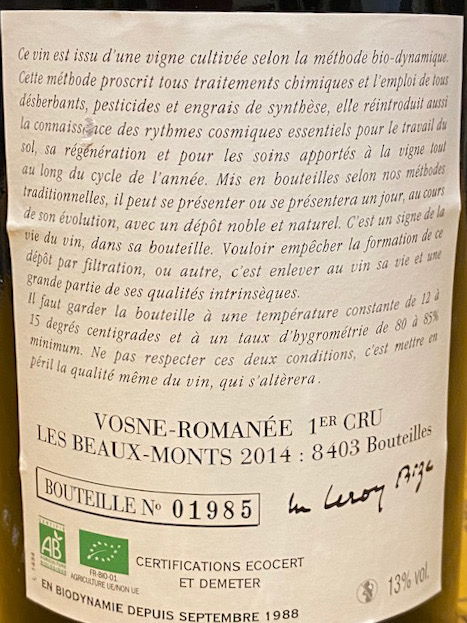The Jérémy Recchione labels attract attention and focus. So do the wines. They started out in 2017 as “regular” organic wines with little sulphur, but evolved further in 2018 and 2019 into wines made and bottled with no sulphur.
CALL OF THE WILD!!
A short Hog-story: Back in 1987, I scared my French relatives by playing some good solid cowpunk with a record made by a band then called Disneyland After Dark (now DAD; apparently the Disney company didn’t like the association. I wonder why?). DAD had just released its first album, Call of the Wild, one of the most uncompromising recordings in Danish music history. Let’s just say that this recording was – and still is – quite far from the average French music style.
All that’s to say that, if the 2017s from Jérémy Recchione are organic, then the 2018s are wild things.
Let’s go to 2018!
Tasting the ’18s at Bar’Vin
Rufus Vin held a small tasting at Bar’Vin, another trusted watering hole in Copenhagen. Present was bar owner Niels Thyge, who is one of the top sommeliers in Denmark and an old friend.
The effect of 10 mg/l sulphur versus a hot vintage
The 2018s were made without sulphur. With the 2017s having 10mg/l of free sulphur, we were able to compare the two vintages and see what effect the sulphur had, and what its absence showed. The 2018 vintage is clearly bigger and more generous than 2017, and this, in combination with the no-sulphur regime, gave quite a different style.
The ’18s are clearly more organic and voluptuous, with more whole-cluster notes as well as cinnamon and spicy floral hints that are expressive and forward. This is the call of the wild, although that said, the signature style is clearly recognisable between the two vintages.
While the 2017 Gevrey-Chambertin is more delicate and precise, as it’s shaped a bit by the sulphur, the 2018 is more forward, lush, and generous – organic if you like – with a character recalling a combination of Pacalet and Prieure-Roch.
To be honest, I was a bit surprised to hear that the 2017s contained as little as 10 mg/l, because the sulphur-free wines were so organic and forwardly opulent in comparison.
We will see if the 2019s will show the same difference. Having tasted it, the 2019 Aligoté indicates more vivid vibrancy (not exactly surprising given the vintage).
However, with some sulphur support, the 2017s will be perhaps welcomed by certain collectors who prefer to avoid risks.
The risks: transporting, storing and maturing
It is pretty clear that non-sulphured wines are more sensitive to temperatures and changes – quite a lot more sensitive.
One really needs to take particular care in transporting, storing, and maturing these wines. Keep them cool – preferably below 12 degrees Celsius – under all circumstances and at all times, including during transport.

If one doesn’t, there can be problems. So please take care.
The tasting on September 9
We tasted the following wines:
- Bourgogne Aligoté “skin contact” 2018 and 2019
- Chardonnay 2018
- Saint-Romain 2018
- Hautes Côtes de Nuits 2018
- Gevrey-Chambertin 2017 and 2018
- Fixin 1er cru Les Hervelets 2017 and 2018
Jérémy Recchione Bourgogne Aligoté 2018
Very fine fruit and acidity for the vintage. It’s rich, with delightful balance and quite an impact from the lees. The lively fruit shows fine verve and a classical aligoté stance. This is a fine expression of the aligoté grape.
(Drink from 2025) – Very Good – (87-88p) – Tasted 09/09/2020 – ![]()
Jérémy Recchione Bourgogne Aligoté 2019
The 2019 Aligoté is much more vivid and – as one taster expressed it – tutti-frutti. The perfumed, vivid aromatics are rather wild, but also very lovely. It doesn’t have the sheer weight of the 2018, but the energy is really showing, with hints of Nordic berries.
(Drink from 2025) – Very Good – (88-89p) – Tasted 09/09/2020 – ![]()
Jérémy Recchione Bourgogne Chardonnay 2018
The Bourgogne Chardonnay was not showing well. Big rather and dense with, at the moment, a slightly oxidative note. This is what I would call a real vin nature, and it’s not to my liking.
(Drink from 2020) – Average – (78-80p) – Tasted 09/09/2020
Jérémy Recchione Hautes Côtes de Nuits 2018
The Hautes Côtes de Nuits is expressive, wild, vivid and very lively, with a cinnamon, organic note. Quite fresh for a 2018 despite showing the opulence and generosity of the vintage. I do like the acidity balance, which gives a very enjoyable stance.
(Drink from 2025) – Very Good – (88-89p) – Tasted 09/09/2020 – ![]()
You need to login as a Premium subscriber to read the rest of this article. If you are not a Premium Subscriber, use the subscribe function and sign-up.

 - A true vin d’émotion – a Burgundy of passion
- A true vin d’émotion – a Burgundy of passion - A truly hedonistic wine – lively and enjoyable
- A truly hedonistic wine – lively and enjoyable - A vivacious wine for pure indulgance
- A vivacious wine for pure indulgance - A Vin Vif - fresh, energetic and with a light appearance
- A Vin Vif - fresh, energetic and with a light appearance
Leave a Reply
You must be logged in to post a comment.